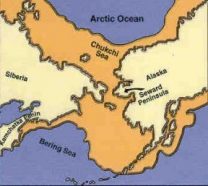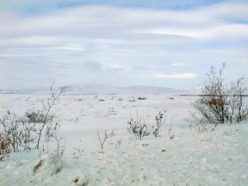A human migration fueled by dung?
When people crossed from Asia to the Americas thousands of years ago, burning dung may have kept them warm.
By Emily Sohn
If you think traveling to Alaska in the winter sounds cold today, imagine what it was like thousands of years ago.
Before the invention of central heating and hot cocoa, it would have been too cold for people to migrate to North America through the frigid tundra—without trees or firewood. Or so scientists thought.
 |
|
Thousands of years ago, a 1,000-mile-wide grassland, forming the Bering Land Bridge (orange), connected Alaska and northeastern Russia. People traveled along this vast plain to enter the Americas.
|
| National Park Service |
Now, researchers suggest that our ancestors could have survived cold-weather travel if they had taken advantage of all the dung lying around.
More than 50,000 years ago, Alaska was connected to northern Russia by a land bridge that is now largely underwater. Yet people didn’t make the crossing until about 14,000 years ago, according to archaeological and genetic evidence. Scientists have long blamed the delay on cold weather and a lack of fuel for heating and cooking.
That might not be the best explanation, says David Rhode of the Desert Research Institute in Reno, Nev., who has studied the dung-burning habits of modern Tibetans. To heat their tents and cook their food, Rhode has observed, a single family living on the Tibetan Plateau burns between 25 and 40 kilograms of dried yak dung in the summer and twice that in the winter. That’s a lot of dung. But the Tibetans are pretty efficient dung-gatherers.
 |
|
A wintry landscape in the region once linked by the Bering Land Bridge.
|
| National Park Service |
Thousands of years ago, Rhode says, the route from Russia to Alaska would have been bursting with big plant-eating animals, like bison, mammoths, horses, and wooly rhinoceroses. With animals comes waste. There should have been plenty of dried dung to fuel the trip.
So, why the delay? Maybe our ancestors took a while to realize the value of the poop along their path.







